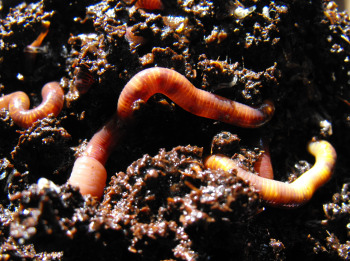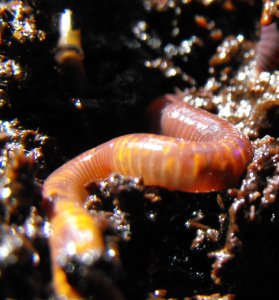
Worm bin question
 I've been meaning to post a
worm update for a while, so I appreciate the question. The savvy
reader will recall that we were given a
bunch of worms three and a half months ago and made
them a low tech worm bin which gave us a bunch of compost tea a
month later. And then I stopped talking about them.
I've been meaning to post a
worm update for a while, so I appreciate the question. The savvy
reader will recall that we were given a
bunch of worms three and a half months ago and made
them a low tech worm bin which gave us a bunch of compost tea a
month later. And then I stopped talking about them.
The reason you didn't hear any more about worms is because they are the
easiest livestock you'll ever have. We feed
all of our kitchen scraps to the chickens, so the only thing which goes
in the worm bin is tea bags (after they've been used twice.)
Contrary to popular wisdom, I just throw the wet tea bags on top of the
bin rather than bothering the worms by burying the tea bags. I
don't even open the tea bags up. The older tea bags get buried by
newer tea bags, and the worms and fungi start to work on the older ones
once they're thoroughly submerged. I poked in the bin a bit
before making this post and was thrilled to see pitch black dirt down
there!
 Which is all to say, don't be
intimidated by worm bins. To answer your specific questions, we
keep our worm bin under the sink, which makes it very easy to toss in
tea bags every day. The garage would probably work, although
worms do best at a temperature of above 55 F. (There are actually
two species of redworms that folks use for vermicomposting, and one is
active at lower temperatures than the other. See here for more
details.)
Which is all to say, don't be
intimidated by worm bins. To answer your specific questions, we
keep our worm bin under the sink, which makes it very easy to toss in
tea bags every day. The garage would probably work, although
worms do best at a temperature of above 55 F. (There are actually
two species of redworms that folks use for vermicomposting, and one is
active at lower temperatures than the other. See here for more
details.)
The only problem we've had with our worm bin is fruit flies, which
seems to be a popular problem which causes many folks to give up on
them. Indifferent housekeeper that I am, I don't particularly
care about a few fruit flies, but if they bug you, this
website lists a bunch of hints for dealing with the problem.
Our only other complaint with our worm bin is that it took us so long
to get started on it! This summer, we plan to expand our
vermiculture operation as much as possible and we highly recommend that
all gardeners do the same.
Want more in-depth information? Browse through our books.
Or explore more posts by date or by subject.
About us: Anna Hess and Mark Hamilton spent over a decade living self-sufficiently in the mountains of Virginia before moving north to start over from scratch in the foothills of Ohio. They've experimented with permaculture, no-till gardening, trailersteading, home-based microbusinesses and much more, writing about their adventures in both blogs and books.
Want to be notified when new comments are posted on this page? Click on the RSS button after you add a comment to subscribe to the comment feed, or simply check the box beside "email replies to me" while writing your comment.
